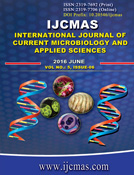


 National Academy of Agricultural Sciences (NAAS)
National Academy of Agricultural Sciences (NAAS)

|
PRINT ISSN : 2319-7692
Online ISSN : 2319-7706 Issues : 12 per year Publisher : Excellent Publishers Email : editorijcmas@gmail.com / submit@ijcmas.com Editor-in-chief: Dr.M.Prakash Index Copernicus ICV 2018: 95.39 NAAS RATING 2020: 5.38 |
Plant based antimicrobials have enormous therapeutic potential as they can serve the purpose with lesser side effects that are often associated with synthetic antimicrobials. Hence, a study was attempted in selected algae and cyanobacteria for antimicrobial activity. Among the various algae used, Spirogyra quinina had the maximum inhibitory effect followed by Zygnema stellinum and Cyclotella comta. Among the various extracts, the chloroform extract showed the maximum inhibitory effect followed by diethyl ether, ethanol and methanol for all the selected algae in the present study. Further, each extract had differential effect on various organisms. However, in general, the effects were more with the bacterial pathogens when compared to the fungal pathogens. Among the various extracts of cyanobacteria used, the chloroform extracts showed the maximum inhibitory effect followed by diethyl ether, ethanol and methanol. Further, among the various cyanobacteria, the extracts of Spirulina major had the maximum inhibitory effect followed by those of Oscillatoria limosa and Nostoc linckia. However, all the extracts showed differential inhibitory effect with different pathogens. Nevertheless, in general, all the extracts appeared to be more effective against bacteria than fungi in the present study. In addition, the present study indicates that chloroform can also be used as a solvent for extracting the antibacterial and 204 antifungal agents. Further, among the cyanobacterial and algal extracts, the algal extracts used in the present study showed higher efficacy towards antibacterial activity. The result of the present study clearly indicates the presence of antimicrobial compounds in the selected cyanobacterial and algal species. However, further studies are necessary to elucidate the components responsible for antibacterial and antifungal activities against microorganisms. It can be concluded that some of the extracts obtained using various solvents used in this study had higher antibacterial and antifungal activities and are more effective when compared with some contemporary antibiotics and fungicides.
 |
 |
 |
 |
 |